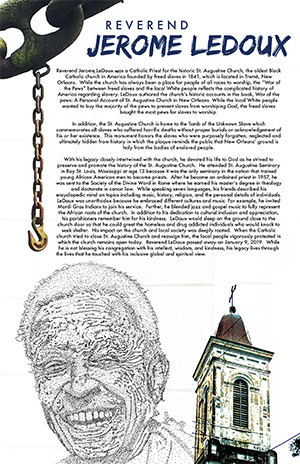Nero Dotson is a third-year undergraduate majoring in Economics and completed the Undergraduate Certificate in Global Urban Humanities in 2019. He is interested in ways that private companies can contribute to low-income communities and the growing role of businesses and their relationship with the communities in need. He was a student in the 2019 GUH Undergraduate Studio course, New Orleans: Historical Memory and Urban Design, co-taught by Profs. Anna Brand in LAEP and Bryan Wagner in English, and writes a reflection about the class trip to the Crescent City.

Congo Square. A historical site and birthplace of jazz where slaves and freed slaves would congregate on Sundays to play music and dance.
The city of New Orleans and its relentless spirit cannot be captured in its entirety because of its eclectic and fascinating synthesis of influences that has created a unique culture. Born out of its mixture of people and cultures, diversity of thought and celebration of differences, the Crescent City may truly reflect America’s ideal values. However, these ideals are not consistently realized due to problems with the structure of power in place combined with the lack of forethought or purposeful design of the city.
I was honored to join a group of ambitious and enthusiastic UC Berkeley Global Urban Humanities students led by Professors Anna Brand in Landscape Architecture and Bryan Wagner in English to take an eye-opening journey to New Orleans. Prior to my journey, I learned about the complexities of the design of New Orleans. The first half of the course dissected the history and current state of New Orleans’ culture while the second half focused on North Claiborne Avenue, a thriving Black-owned business district formed due to segregation and disrupted by the construction of the Interstate-10 highway.
Absorbing knowledge from readings, research and personal experiences from professors, and discussions with experts and guest speakers transformed into on-site fieldwork where I used all five senses of sight, hearing, smell, taste, and touch to viscerally experience New Orleans for five days. We spoke with the residents who lived and witnessed the rapid change of the city. In fact, residents nicknamed New Orleans “Little San Francisco” due to the increasing prevalence of gentrification, including the displacement of residents, changing demographics of neighborhoods, and altering the culture of Tremé, a historic African American neighborhood. We also met prominent community leaders, such as Lambert Boissiere (public servant), to hear their opinions about the accelerated changes of New Orleans. Demond Melancon, Big Chief of the Young Seminole Hunters and contemporary artist, echoed his concern for the sudden changes in the city with the hope that it could eventually come back.

Paper Monument poster created by Nero Doston and Angela Phung on Rev. Jerome LeDoux of St. Augustine Church, the oldest Catholic church founded by freed slaves
The most important takeaway from this experience was the resilience of the residents and their strong ties with their culture, local and beyond. Regardless of the intentional planning of the freeway to disrupt Black business progress, the community reclaimed the area by embracing the changes to the Claiborne district. During my cultural immersion, I attended the Tremé 7th Ward Festival under the freeway, danced in the Second Line celebration, and tasted the incredible cuisines offered by the local restaurants.

Second line parade under Interstate-10 on North Claiborne. Photo credit: Daniel Olea
The GUH studio course allowed me to gain a holistic understanding of New Orleans, its culture, and the perspective of the locals who are undergoing rapid transformation in real time. This course delivered an interdisciplinary approach to studying cities, from critical thinking about urban spaces to project collaborations with my classmates. As a business administration and economics double major, I was able to work on projects with classmates with broad interests and diverse majors. I observed the differences in how my classmates and I approached, thought, and interpreted information and experiences which led to a better and more complete understanding and appreciation of New Orleans, as well as my classmates. In the end, I was inspired to continue my research of North Claiborne Avenue with Professor Brand that will trace Claiborne's history as a thriving Black urban sphere to the gentrification pressures in the wake of Hurricane Katrina. Using critical race methodological approaches and community engagement, we will help build the framework for a digital humanities project on Black mecca histories and futures.

Group photo on Bourbon Street (L to R): Jade Wong, Cherry Wu, Madison Roberts, Fabiha Fairooz, Claire Kostohryz, Nero Doston, Daniel Olea



